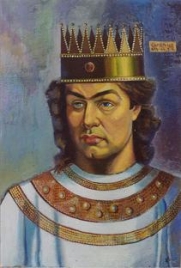Varazdat
Thursday, August 25, 2022
Varazdat was the king of Arsacid Armenia from 374 until 378.
Varazdat was the nephew and successor of the previous Arsacid Armenian king Papas (Pap), who reigned from 370 until 374. According to Saint Mesrop Mashtots, the priest and historiographer of the Catholicos Nerses the Great, names the father of Varazdat as Anob, while the identity of the mother of Varazdat is unknown. The father of Varazdat, Anob who was an Arsacid prince was the older paternal half-brother of Papas. Also, according to Faustus of Byzantium (Book IV, Chapter 37), Varazdat proclaims himself as the nephew of Papas and the historian reveals Varazdat's relations to the Armenian Arsacids. Hence the paternal grandfather of Varazdat was the Arsacid monarch Arsaces II (Arshak II), who ruled as Roman client king of Armenia from 350 until 368 as his paternal grandmother was an unnamed woman whom Arsaces II married prior to his Armenian kingship, who died before the year 358. Little is known of his early life.
Sometime before his Armenian kingship, Varazdat participated in the Olympic Games in Greece. He is often regarded as one of the last competitors in the Ancient Olympic Games. Varazdat's victory in the bare-knuckle boxing event (pugilat) is recorded in Moses of Chorene's History of Armenia (3.40). Since he reigned from 374 until 378, conjecture places his victory in the 360s. Varazdat is the second recorded Armenian to participate in the Olympic Games, while the first was his ancestor Tiridates III of Armenia, before he served in his Armenian kingship. Varazdat's victory is also known from a surviving memorandum which is now kept at the Olympic Museum in Olympia, Greece.
According to the "Chronicle of Eusebius," the Olympic Games were banned in 394 by Emperor Theodosius as pagan. Accurate evidence of the latest games are missing: it is believed that the 293rd Olympic Games did not take place. Thus, the Armenian king Varazdat was one of the last winners of the ancient games.
An initiative from the Armenian National Olympic Committee on May 8, 1998, a statue bust of Varazdat was installed at the International Olympic Academy in Olympia, Greece. The sculptor of Varazdat's statue bust was Levon Tokmajyan.
Following the assassination of his uncle Papa, Roman emperor Valens sent Varazdat, who as a young man was highly reputed for his mental and physical gifts, to occupy the Armenian throne. At that time, Varazdat had been living in Rome for an unknown period of time. Varazdat began to rule under the regency of Mušeł I Mamikonian, whose family were pro-Roman.
The Sasanian emperor Shapur II, having failed on the battlefield, now proposed to Valens in 375 that Armenia which he called the perpetual source of trouble, be evacuated or that Roman forces be withdrawn from the western part of Caucasian Iberia ruled by Sauromaces. The emperor rejected the proposal but sent two legates, the magister equitum Victor Magistrianus and Urbicius the dux of Mesopotamia to the Persian king to discuss the question. Shapur II was told that his demands were unjust because the inhabitants of Armenia had been granted the right to live according to their decisions. Shapur II was also told that unless Roman troops assigned to protect the Iberian king in the west were allowed to pass unhindered, Shapur II would be forced into war with Rome. Valens was confident of this threat because he was counting on filling the ranks of his army with auxiliaries from the Goths that he had permitted to settle in Thrace. The two legates made a blunder during their return trip by accepting two regions (Asthianene and Belabitene) under Roman rule without proper authorization. This gave Shapur II a new bargaining chip to revive negotiations and in late 376 he sent Suren with an embassy offering Valens these two regions illegally accepted by the legates in exchange for Roman concessions. Suren was sent back with the message that Rome was unwilling to negotiate and would launch a tripartite invasion of Persia the following spring in 377. Shapur II responded by seizing back Asthianene and Belabitene and harassed the Roman troops in western Iberia. The Goths revolted in early 377 and Valens was forced to negotiate, eventually withdrawing Roman forces from Armenia in order to use them against the Goths. Valens himself died fighting the Goths in August 378 during the Battle of Adrianople.
Varazdat like his uncle, aggressively promoted Arian Christianity.
The situation in Armenia deteriorated even further. Sometime after the withdrawal of the Roman forces, Varazdat killed the regent Mushegh Mamikonian. The vacant position of sparapet was quickly filled by Manuel Mamikonian who had served under Shapur II in the most recent Kushan war. Manuel took up arms against Varazdat and forced him to flee from Armenia in 378, after four years of reign. Varazdat sought refuge in Rome. Manuel together with Papas' widow Zarmandukht, and their first son Arsaces III (Arshak III) formed a new provisional government allied with Persia. Shapur II garrisoned a 10,000 man army in Armenia under Suren, much like Valens in 377. Eventually, Manuel revolted against Persia and defended Armenian sovereignty against both Rome and Persia throughout the 380s until his death.
Valens sent Varazdat to the British Isles. Varazdat most probably died in exile, and the date of his death is unknown.
Archaeological evidence and the ancient Armenian and Roman historical sources of the period do not indicate that Varazdat had a wife or any children. However, modern genealogies present Varazdat as being the father of Khosrov IV and Vramshapuh.





